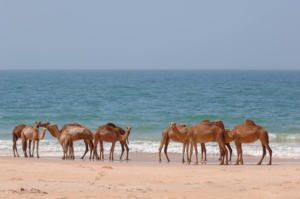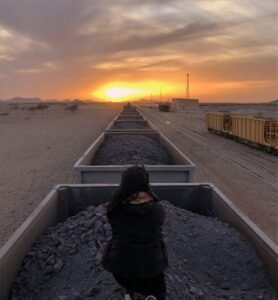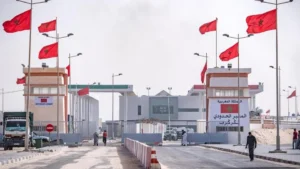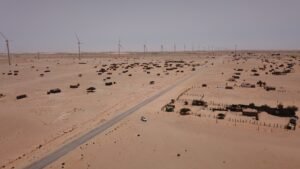Imagine a gigantic convoy over 2.5 kilometers long, crossing the vastness of the Mauritanian Sahara under a scorching sun. No stations, no comforts, just the sound of wagons loaded with iron ore and the wind whipping your face. This is no simple train ride, it’s a raw, intense, timeless experience.
In this article, we take you on board the world’s longest and heaviest train, linking the mines of Zouerate to the port city of Nouadhibou in Mauritania. We’ll tell you all about the history and importance of this railroad line, but above all we’ll tell you how to experience this extreme adventure, between breathtaking desert landscapes and total immersion in Mauritanian culture. We’ll also share practical tips on how to prepare for this extraordinary trip, and make it as unforgettable as it is comfortable (or almost!).




What makes this adventure so unique?
Welcome aboard Mauritania’s mineral train, the steel monster that crosses the Sahara. This is no tourist train, still less a TGV with bar car and reclining seats. No online ticketing, no air-conditioning, no restaurant car to sip coffee in. No. You climb straight onto a pile of iron ore, in the middle of the desert, for an 18-hour journey in some of the world’s most extreme conditions.
Why do this to yourself? Because it’s a real, raw adventure. A timeless journey of solitude, unforgettable encounters and lunar landscapes. In short, an experience to be had at least once in your life – and maybe not twice, depending on your dust tolerance threshold.
The story of Mauritania’s ore train
Today managed by SNIM (Société Nationale Industrielle et Minière), this train is not new. It was built in 1962 by the French of the former MiFerMa to transport iron extracted from the Zouerate mines to the port of Nouadhibou, over 700 km away.
Today, it remains one of the longest and heaviest trains in the world:
- 2.5 kilometers long
- Up to 210 carloads of ore
- Over 17,000 tonnes of iron transported per trip
This metal monster is the backbone of Mauritania’s economy, linking the country’s interior to the coast for the export of iron to Europe and Asia. But for travelers, it’s above all a unique opportunity to experience an extreme adventure in the heart of the desert.
The train route: Zouerate to Nouadhibou
📍 Distance: 704 km
⏳ Duration: between 16 and 18 hours
🌡 Temperature: +40°C during the day, close to 0°C at night
The iron-filled train leaves Zouerate, crosses the Tiris Zemmour region and plunges into an ocean of sand. On the way, we pass through Choum, a small village that often serves as a disembarkation point for those wishing to avoid the roughest part of the journey.
Along the way, the landscape is mesmerizing: endless dunes, rocky mountains and absolute silence, disturbed only by the rumble of the train. Occasionally, goats and sheep pile onto the wagons, transforming the convoy into an improvised Noah’s Ark.
How to board the train
Boarding Mauritania’s ore train isn’t a matter of booking a ticket in advance or consulting a precise timetable. Here, everything works the old-fashioned way: you have to get there, observe, ask the locals questions and wait for the train to depart. Travellers have two options: the passenger wagon, which is not free but often crowded, or the ore wagons, which are free but rudimentary.
The passenger carriage, known as the “dweira”, is the only part of the train officially intended for passengers. It is located at the rear of the train and offers a semblance of shelter from dust and wind. Access is subject to a fee, with a ticket costing around 250 MRU (€6). However, this carriage is crowded well before departure and quickly becomes saturated with passengers and luggage, making it difficult to move around once you’ve settled in. There’s no guarantee of a seat, and the atmosphere can quickly become oppressive, especially on hot days.
The other option is to climb straight into an ore wagon, without paying a ticket. This is the most authentic solution , but also the most exhausting. You have to climb onto a load of crushed iron, sit on it as best you can and endure the jolts of the train without any shelter. This choice also means having to put up with the omnipresent dust, which seeps into your clothes, bags and even your lungs. Comfort is non-existent, and the cold becomes biting once night falls. Nevertheless, this option offers a breathtaking view of the desert, far from the confinement of the passenger car.
In Nouadhibou, the train departs from a station on the outskirts of town, which is difficult to locate without directions. Taking a cab is the easiest way to get there, for a fare of around MRU 50. In Zouerate, the train doesn’t leave from the city center, but from Fderik, a small town some ten kilometers away. It is necessary to arrange transport to the departure point, as there is no regular service to this mining area.
Train departures do not follow a fixed schedule. In general, the convoy leaves Nouadhibou every day in the late afternoon, between 3pm and 6pm, but sometimes it leaves earlier, as early as 1pm. The wait can be long under the sun, but it’s best to arrive early to avoid any unpleasant surprises. Once the train is in motion, there’s no turning back: you’ll have to hold on until you reach your destination, whether it’s Choum after a ten-hour journey, or Nouadhibou after around 18 hours if you’re coming from Zouerate.
In a nutshell
Seating in the passenger car (“dweira”)
- The only “official” carriage on the train, but always packed.
- Ticket: approx. 250 MRU (€6).
- Seating uncertain.
Or settle into a free ore wagon
- Pure adventure, but zero comfort.
- You’re traveling on a carpet of crushed iron.
- No one will bother you for a ticket.
Where to take the train?
- In Nouadhibou: The railway station is on the outskirts of town. Take a cab (50 MRU).
- In Zouerate: The train often departs from the Fderik mining area (10 km west of Zouerate).
Schedules (approximate, never exact) :
- Departures every day in the late afternoon (between 3pm and 6pm, but sometimes earlier).
- It’s best to arrive early to secure a place.




Onboard experience: Here’s what to expect
Right from the start, iron ore dust is everywhere. The sun beats down hard, turning the metal wagons into hotplates. The dry air irritates the throat, and the black dust sticks to skin and clothes. After a few hours, everything seems to be covered in a thin layer of iron.
The noise is constant. Every bump between the cars resonates heavily, making conversation difficult. The jolts are abrupt, and the journey is far from smooth.
As night falls, the warmth abruptly disappears. The icy wind blows through clothing, making sleep almost impossible without a thick comforter. Those who have brought a tarpaulin or blanket wrap themselves in it to limit heat loss, while others shiver and wait for dawn.
The train is a mix of travelers and local workers. Traders watch over their wares, herders travel with their goats perched on the ore, and a few adventurers take advantage of the journey to observe the desert under a starry sky. Despite the discomfort, the atmosphere is often marked by exchanges and knowing glances between those sharing this unique experience.
🔥 Daytime: hot and dusty
- The heat is intense, especially in summer.
- Sand and iron dust infiltrate everywhere (clothes, bag, nostrils, soul…).
- The noise from the cars is deafening.
❄ The night: icy and windy
- As soon as the sun sets, temperatures plunge.
- A warm comforter is essential to avoid hypothermia.
🤝 Meetings on board
The train is a melting pot:
- Merchants who transport goods.
- Farmers with their goats and sheep.
- Intrepid travelers come to test their limits.
- And sometimes even journalists and film-makers in search of spectacular images.
Essential equipment for surviving the trip
✅ A turban (haouli) or mask to avoid eating dust.
✅ Ski goggles or swimming goggles to protect your eyes.
✅ A tarpaulin to lie on the ore (and avoid looking like an iron statue on arrival).
✅ A warm comforter for the night.
✅ Dark clothes (because you’ll end up black with dust anyway).
✅ Water and food for 18 hours (no service on board).
✅ Garbage bags to protect your backpack.
Back to civilization: where to sleep?
Choose the Hôtel Prestige the best address for an even more pleasant… and economical stay.
Book now and take advantage of our exceptional offers.
Check availability and find the room that suits your needs.
📩 Need more help? Consult our booking guide or contact our team, who are always ready to help.
Hotel Prestige awaits you!







